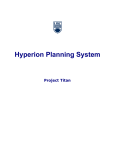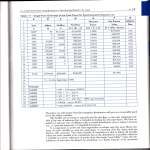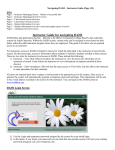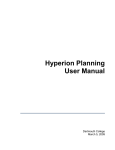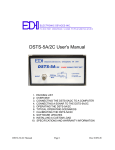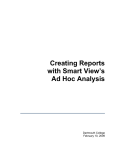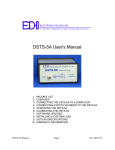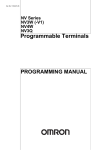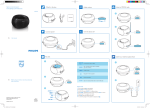Download Training Guide - UBC Information Technology
Transcript
Campus-Wide Budgeting System Oracle Hyperion Planning Tutorial version 7.0 Contact Information [email protected] http://www.it.ubc.ca/projects/strategicprojects/titanatlas.html Campus-Wide Budgeting System Oracle Hyperion Planning Management Tutorial Developed by the TITAN Development team University of British Columbia A joint project by IT and Finance Campus-Wide Budgeting System Tutorial / i TABLE OF CONTENTS BEFORE YOU BEGIN… .............................................................................. 1 Background Info .........................................................................................................................1 Other References .........................................................................................................................1 GETTING TO KNOW THE CAMPUS-WIDE BUDGETING SYSTEM .......... 3 First Thing’s First – Understanding how the System Works ..................................................3 Some Basic Concepts................................................................................................................3 Some Technical Concepts .........................................................................................................7 10,000-foot View of the End-to-End Process ...........................................................................10 Exercise 2-1 – Launching the Campus-Wide Budgeting System ..........................................11 Exercise 2-2 – Opening a Planning Application .....................................................................13 Exercise 2-3 – Navigating the Content Area (workspace) .....................................................14 Exercise 2-4 – Collapsing and Expanding Data Entry Areas and Forms ............................17 Exercise 2-5 – Selecting the Dimensions to Work With .........................................................18 PLANNING AND FORECASTING ............................................................. 25 Exercise 3-1 – Creating a Plan .................................................................................................25 Exercise 3-2 – Updating your Forecast (self study) ................................................................29 Exercise 3-3 – Setting a Long-Range Forecast (self study) ....................................................30 Exercise 3-4 – Planning by Using a System Function.............................................................31 Exercise 3-5 – Spreading Data Using Grid Spread ................................................................39 Exercise 3-6 – Adjusting Totals Using Grid Spread ...............................................................41 BUSINESS RULES .................................................................................... 47 Exercise 4-1 – Identifying the Business Rules Available to the Data Form (self study) ......47 TRANSFERS.............................................................................................. 53 Exercise 5-1 – Transferring GPO Funding to another Unit ..................................................53 ii Exercise 5-2 – Accepting / Rejecting GPO Funding Transfer .............................................. 57 WORKFLOW ............................................................................................. 65 The Planning Unit .................................................................................................................... 65 Exercise 6-1 – Viewing the Status of a Planning Unit ........................................................... 66 Exercise 6-2 – Submitting a Plan ............................................................................................ 68 Exercise 6-3 – Reviewing / Approving a Planning Unit ........................................................ 69 THE TASK LIST – YOUR TO-DO LIST ..................................................... 73 What is a Task List? ................................................................................................................. 73 Exercise 7-1 – Viewing your Unit’s Task List ........................................................................ 73 WORKFORCE ........................................................................................... 79 Exercise 8-1 – Viewing the Status of Existing Positions ........................................................ 79 Exercise 8-2 – Viewing Existing Position Information .......................................................... 80 Exercise 8-3 – Planning Overtime for the Year ..................................................................... 83 Exercise 8-4 – Entering New Position Information ............................................................... 84 Exercise 8-5 – Making a high-level planning adjustment to salaries or benefits ................ 86 REPORTS.................................................................................................. 91 Financial Reporting vs. Web Analysis .................................................................................... 91 Financial Reporting ................................................................................................................ 91 Web Analysis ......................................................................................................................... 91 Planning Data Sources ........................................................................................................... 92 Access to report content ......................................................................................................... 92 Browsing the Repository ........................................................................................................ 92 Interacting with Web Analysis Report ................................................................................... 93 Exercise 9-1 – Access Web Analysis Reports in HTML ........................................................ 94 Exercise 9-2 – Interacting with Web Analysis Reports ......................................................... 96 Exercise 9-3 – Analysis Tools – Traffic Lights ....................................................................... 97 Exercise 9-4 – Analysis Tools – Calculation (self study) ....................................................... 99 Exercise 9-5 – Preview Financial Reporting Reports in HTML or PDF ........................... 102 iii Exercise 9-6 – Export the Report to Excel ............................................................................106 LAST, BUT NOT LEAST… ...................................................................... 109 Logging off of the Campus-Wide Budgeting System ...........................................................109 Appendix A – Menu items ......................................................................................................110 Appendix B – Toolbar Buttons ..............................................................................................113 Appendix C – Navigation Shortcuts ......................................................................................114 Contact Information [email protected] http://www.it.ubc.ca/projects/strategicprojects/titanatlas.html Campus-Wide Budgeting System Tutorial / 1 Before You Begin… Background Info I n fall of 2008, UBC embarked on a review of the Consolidated Budget Process and conducted in-depth interviews with the executive, administrative staff, faculty finance officers, faculty staff representatives and departmental staff about their concerns with the current budget process and software/system. It was identified that the existing processes and systems including budgeting and management reporting did not meet the needs of the campus community. The objective of this project is to implement new university wide budgeting processes and systems that meet Budget Office as well faculty and departmental requirements. The implementation phase began in mid-November 2009 and is expected to run until October 2010, in time for the 2011/12 budget cycle starting in October 2010. . Other References This tutorial guides you through some of the features of the Budgeting System. However, complete details can be found in the Campus-Wide Budgeting System User Manual. Stay up to date with the goings on of the Titan/Atlas Project by visiting this website regularly http://www.it.ubc.ca/projects/strategicprojects/titanatlas.html You are always welcome to send e-mail to the team, at [email protected] Contact Information [email protected] http://www.it.ubc.ca/projects/strategicprojects/titanatlas.html Campus-Wide Budgeting System Tutorial / 3 Getting to Know the CampusWide Budgeting System What will you learn in this lesson? Some of the most important concepts that define the data you see and work with. A few technical concepts to help you get acquainted with the system itself. The high level view of the end-to-end process. How to launch the Campus-Wide Budgeting System. How to navigate through the Budgeting System‟s workspace. Manipulate the workspace “real estate”. Open the application called “Planning”. Working with Scenarios and Versions; what they mean to your planning exercise. First Thing’s First – Understanding how the System Works SOME BASIC CONCEPTS Dimensions Dimensions are structural elements of an application that describe and hold data. Dimensions provide perspective on the data being analysed. The main dimensions used for Planning at UBC are Scenario, Version, Account, Entity, Year, Period, Project Grant, Fund and Program Code. Dimensions and combinations of dimensions define a Point of View. Contact Information [email protected] http://www.it.ubc.ca/projects/strategicprojects/titanatlas.html 4 / Chapter 2 - Getting to Know the Budgeting System Dimensions represent categories of data. For example, when you enter budget data in a plan you must identify what item you are budgeting. Budget items such as travel expenses and salary expenses are in Account dimensions. You must also identify the time period for each item. Time items such as current quarter and next quarter are in the Period dimension. Scenario and Version Dimensions You can use the scenario and version dimensions to create individual plans that can be reviewed and approved. For each entity, the scenario and version combination contains its own set of data for accounts and for other dimensions. After entering entity data for scenarios and version you can submit or promote the data to other users for review and approval. The intersection of entity, scenario and version is referred to as a Planning Unit. Working with scenarios enables you to group data and to place each data group in a separate plan with its own review cycle. Scenario describes the type of plan data (such as budget, actual or forecast) and the time span that the plan covers. For example, your organization might require a one-year revenue plan and a three-year revenue plan. The plans might be prepared by different users and follow different review paths. For this purpose, the unit’s administrator can create two scenarios – Current-Year Revenue and 3-Year Forecast. Scenarios are assigned start and end years and periods. You can enter data into data forms only for scenarios that are within the start and end range specified by your administrator. The scenarios used in the Campus-Wide Budgeting system are: ―Plan‖, ―Forecast‖, ―Long Range Forecast‖ and ―Actuals (ACT)‖ Access rights to scenarios are assigned by your administrator. If you do not have access to a scenario, you cannot enter data on a data form for that scenario. Versions allow for flexibility and iterative planning cycles. For examples, your application can have 4 versions – ―define‖, ―approve‖, ―working‖, and ―draft‖. At any given time there are several combinations of Scenario and Version accessible to users. For example, at the end of Q2, FY10 (September 2009) the following combinations are available: FY08 FY09 FY10 FY11 FY12 FY12 FY13 Approved Approved Approved - - - - Plan - - Approved Working - - - Forecast - - Working - - - - Long Range Forecast - - Working Working Working Working Working Actuals Campus-Wide Budgeting System Tutorial / 5 Account Dimensions This dimension specifies the FMS account for which data is to be entered budget planners. Examples of accounts are ―Sales and Services (add account #)‖ and ―Travel (add account #)‖. (Add hyperlink to Hyperion / FMS accounts – not yet available). PG Dimensions This dimension specifies PG from FMS. PGs are generally in the following format 12Z12345. Entity Dimensions This dimension specifies the organizational structure. The main structure is based on the FMS AllDeptids Tree. Alternate structures are also available (e.g. by campus). Because account codes and department codes in FMS are in the same format and sometimes overlap, the departments in Hyperion have been prefixed with a ―D‖, e.g. D321000. Year Dimensions This dimension specifies the fiscal year for which data is to be collected from budget planners. Examples of Year are FY10, FY11. Period Dimensions This dimension specifies the month for which the data to be collected from budget planners. Examples of Period are April, May. Fund Dimensions This dimension specifies Fund for which the data is to be collected from budget planners. Examples of Funds are G0000, R3554. Program Code Dimensions This dimension specifies the Program Code for which the data is to be collected from budget planners. Contact Information [email protected] http://www.it.ubc.ca/projects/strategicprojects/titanatlas.html 6 / Chapter 2 - Getting to Know the Budgeting System Members The elements that compose a dimension are called members. Members are discrete components that, in combination with other members, form a dimension. For example, UBCO and UBCV are members of the Entity dimension. Data is entered at the base-level of the member, not the upper-level member of the dimension. In other words, you can enter data in the lowest level child member. All parent-level members are read-only. See the Genealogical Relationships section for more details. A dimension may have multiple members. Some of those members can have their own ―child‖ members. The values of the parent-level members are aggregated from the values of their children. Genealogical Relationships The entire system functions on the parent and child relationship and the point of view premise. The members of a dimension are arranged into hierarchies. Members that have members under them are known as ―parent‖ members. The members immediately below a member are the children of the member that is directly above them. Members that have the same parent are known as ―siblings‖. Points of View A point of view (POV) defines the context of the data. A POV defines what data will be retrieved from the database and displayed on the data form. A POV is made up of intersecting data elements, such as Department, PG and Program Code, to give context to the data. FIGURE 1: The combination of the selected data elements (dimensions) gives context to the data on the page. Campus-Wide Budgeting System Tutorial / 7 Examples of points of view: Example 1 Example 2 Scenario Act Scenario Plan Version Approved Version Working Fiscal Year FY09 Fiscal Year FY11 Period Apr, May, Jun Period QTR2 Department D321000 Department Faculty of Arts Users select the dimensions that will make up the point of view for the selected data form to work with. For more information on POVs, refer to the Campus-Wide Budgeting System User Manual. SOME TECHNICAL CONCEPTS Elements of Data Forms You use data forms to enter data. The elements on the data form enable you to navigate the form and to select and enter data. You may enter or edit data only when your system user profile has the security privileges, as set by the unit’s systems administrator. Contact Information [email protected] http://www.it.ubc.ca/projects/strategicprojects/titanatlas.html 8 / Chapter 2 - Getting to Know the Budgeting System Use of Colours The systems administrator sets up data forms to show certain dimensions and members, reflected by the row, column headings and Point of View. Cells display the data for the selected members. Background colors indicate: TABLE 1: There is special significance to the colour of the cells on the data form. COLOUR INDICATION Pale Yellow Default, database value Highlighted Yellow ―dirty‖ cells, whose values changed but are not yet saved Light green read-only cells Tan locked cells Teal cells having supporting detail Data Forms Data forms are spreadsheet-like grids with rows and columns into which data can be entered. They reside inside folders. When you select a folder a list of data forms is displayed in the view pane and in the content area. From the list of data forms, open a data form by selecting it from the content area or the View pane. Campus-Wide Budgeting System Tutorial / 9 Business Rules Business rules can be launched directly from Planning or they can be associated with data forms. Users who have data-entry privileges on a data form can see and launch only the business rules to which they have access (based on security settings of user profile), regardless of the number of business rules attached to the selected data form. Some business rules launch automatically while others prompt the user for input when they are launched. NOTE: Some business rules must be run in a certain order. For example, if launching both a currency conversion business rule and a sub-total business rule, the currency conversion business rule must be launched before the sub-total rule. Working with Multiple Applications You can open several applications simultaneously — or the same application multiple times — and navigate among them by clicking their names on the tabs at the bottom of the content area window. Contact Information [email protected] http://www.it.ubc.ca/projects/strategicprojects/titanatlas.html 10 / Chapter 2 - Getting to Know the Budgeting System 10,000-foot View of the End-to-End Process Every user of the system will use this system in different ways and for different purposes but all for the common goal of defining, refining and managing the university’s budget. The following process flow illustrates the high level view of the overall process of working with the system. Of course, once inside the system we go from the 10,000-foot view to the more granular activities. Some of those activities include, but are not limited to: Viewing data Updating data Update plans Record funding changes Running business rules Transferring funds from one unit to another Request approvals Create budget plans Set forecasts Consolidate data by portfolio Set system preferences View task lists Attach supporting documents Etc. Campus-Wide Budgeting System Tutorial / 11 This tutorial covers only a very small exemplar of what we can do in the CWBS. The CampusWide Budget System User Manual is a complete reference guide to the system’s features. Exercise 2-1 – Launching the CampusWide Budgeting System Every UBC staff member authorised to work in the Campus-Wide Budgeting System (CWBS) has access to the system via the UBC Portal (CWL). Any user wishing to work in the Campus-Wide Budgeting System must first log in to CWL (For training see #2 below). Once logged in, click the link to the Campus Wide Budgeting System in the Management Systems portal. Scenario: It’s quite simple really! You can’t use the Campus-Wide Budgeting System without launching it (to start it up, in other words)! Prerequisite: You must be authorized to use it and you must have your own valid user id and password. Contact Information [email protected] http://www.it.ubc.ca/projects/strategicprojects/titanatlas.html 12 / Chapter 2 - Getting to Know the Budgeting System 1. Open Internet Explorer. NOTE: You must allow pop-ups and if asked for access to your clipboard, click Yes. 2. For the purposes of training, type in the following URL: http://digby.adm.ubc.ca:19000/workspace/index.jsp. 3. Press the Enter key. The portal‟s Home Page opens. 4. Enter your user name and login from the Training Login Sheet 5. The Budgeting System‟s Home page opens. FIGURE 2: Users‟ Home page may be different for every user depending on individual user settings. Campus-Wide Budgeting System Tutorial / 13 Exercise 2-2 – Opening a Planning Application In the Planning component all data is processed inside applications. An application is a related set of dimensions and members that meet a specific set of analytic or reporting requirements. Scenario: Opening the planning applications (UBC has two applications; UBCPlan and FundPlan). Prerequisite: You must be logged into the system. 1. 2. From the Home Page, click the Applications link. Click the UBCPlan application. This opens the budgeting workspace. Contact Information [email protected] http://www.it.ubc.ca/projects/strategicprojects/titanatlas.html 14 / Chapter 2 - Getting to Know the Budgeting System Exercise 2-3 – Navigating the Content Area (workspace) Use the View Pane on the page's left side to view folders and data forms. To open a data form, double-click a folder name, and click a data form's name. The data form opens in the content area on the page's right side. The window also provides several tools for selecting tasks and documents: Planning menus Planning toolbars The View Pane Scenario: You may want to move around inside the application to see how things work, to get to know it a bit before using it. Prerequisite: The Campus-Wide Budgeting System must be running. That’s it! 1. In the view pane, click the Forms folder, and then the 2. Plan folder. Open the data form General Expense Input Demo – Plan2. The selected data form opens up in the content area. 2. The workspace is that large window that takes up most of the screen. 3. The area on the left of the workspace is the View Pane. Campus-Wide Budgeting System Tutorial / 15 FIGURE 3: Familiarise yourself with the different elements of the workspace. 4. To make more room for your work, you have a few options o To hide or show the View Pane at the page's left side, click View and then View Pane. o Click on the View Pane or Content Area Adjuster. o Click, hold and drag the view pane to resize it. o Click on the upper-right corner to maximize or minimize the content area. How you navigate depends on whether you have just clicked in a cell or are editing the contents of a cell. For example, when you click in a cell, you can press the Right Arrow key to move to the next cell in the row. When you are editing data in a cell, press the Tab key to move to the next cell or click inside the cell with your mouse. 5. When clicking in a cell and not entering or editing cell data, to move: o Forward, backward, up, or down, press the Right Arrow, Left Arrow, Up Arrow, or Down Arrow key. o To the next cell in the column, press Enter. o To the previous cell in the column, press Shift + Enter. Contact Information [email protected] http://www.it.ubc.ca/projects/strategicprojects/titanatlas.html 16 / Chapter 2 - Getting to Know the Budgeting System 6. When entering or editing data in cells, to move: o Forward or backward within the cell data, press the Left Arrow key or the Right Arrow key. o To the next cell in the row, press Tab or click in the next cell. o To the previous cell in the row, press Shift + Tab. o To the next cell in the column, press Enter. o To the previous cell in the column, press Shift + Enter. Campus-Wide Budgeting System Tutorial / 17 Exercise 2-4 – Collapsing and Expanding Data Entry Areas and Forms You can expand data forms and the data entry area—including the view pane—in several ways. Scenario: You may want to move around inside the application to see how things work, to get to know it a bit before using it. Prerequisite: The Campus-Wide Budgeting System must be running. That’s it! 1. Open the Data Form General Expense Input Demo – Plan2. 2. Take an action: To resize: Click the View Pane's right border, hold and drag to resize it. To expand or collapse the View Pane: Click View and then View Pane, or click, hold and drag the view pane to resize it. To hide or show the view pane: Click in the screen's upper-right corner. This button is directly above the vertical scroll bar at the very right of the window. Contact Information [email protected] http://www.it.ubc.ca/projects/strategicprojects/titanatlas.html 18 / Chapter 2 - Getting to Know the Budgeting System Exercise 2-5 – Selecting the Dimensions to Work With From a form, you can see the dimensions available for selection in the page view, change the drop down selections as required and plan a PG. Certain dimensions will be predefined in certain forms and modifications are not allowed (in the example below only 4 of the dimensions can be modified) Scenario: Open the form “General Expense Input Demo –Plan2” and navigate to the PG you’ve been assigned for Training (00GTRAIN) in the DeptID on your Training Login Sheet. Prerequisite: You must be logged in with your assigned training ID. 3. 1. Log into Hyperion. 2. From the CWBS Home Page, open the UBCPlan application. Open the Plan folder. Campus-Wide Budgeting System Tutorial / 19 4. Open the form General Expense Input Demo – Plan2. Click Yes when the message appears about the file being very large and could take considerable time to load. 5. Use the available drop-down menus to select the dimension included on your Training Login Sheet. DIMENSION DATA TO SELECT Fund G0000 Department (your assigned department as per the Training Login Sheet) PG 00GTRAIN Contact Information [email protected] http://www.it.ubc.ca/projects/strategicprojects/titanatlas.html 20 / Chapter 2 - Getting to Know the Budgeting System Program Code 6. PC_DEFAULT Click Go. This loads the Planning form for the Point of View specified. What you’ve done and what it all means This chapter showed you some of the key architectural concepts that give this system its power, how to start the CWBS application and how to move around some of its components. Don’t be afraid to try navigating around the system on your own; see what happens. The worse that could happen is that an option may not become available from your current location. When you feel confident, explore the following chapters. Summary The entire system is governed by a security architecture whereby every user‟s profile restricts what he/she can do in the system. The CWBS interacts with other university systems, e.g. RISe, Position Management, Viking, Student Information System, etc. The CWBS pulls data from these external systems for financial planning purposes. Dimensions, otherwise known as „categories‟ describe and hold data. Dimensions are used to define the context to the data entered and displayed, e.g. Project Grant, Fiscal Year, Faculty, etc. Scenarios group data and place it in separate plans with their own review cycles, e.g. Budget, Plan, Actuals. Versions are iterative planning cycles, e.g. Working, Approved, Draft, etc. Members are lower level elements of a dimension that hold the data. Members may contain other members. Data can be entered only in the lowest member level of the hierarchy. A Point of View is the combination of a Scenario, Version, Fiscal Year, Department, and Project Grant. Campus-Wide Budgeting System Tutorial / 21 Data is always entered on a Data Form. Data forms reside inside the Forms folder. The Forms folder is accessed from the navigation View Pane. Some data forms can have associated business rules. A user role defines what that user can do inside the system, e.g. update data, run a business rule, run reports, approve a plan, etc. Contact Information [email protected] http://www.it.ubc.ca/projects/strategicprojects/titanatlas.html Contact Information [email protected] http://www.it.ubc.ca/projects/strategicprojects/titanatlas.html Campus-Wide Budgeting System Tutorial / 25 Planning and Forecasting What will you learn in this lesson? How to create your initial plan. How to update your forecast. How to set a long-range forecast. Exercise 3-1 – Creating a Plan Scenario: It is the beginning of November 2009. The Budget Office wants all departments to create their financial plan for the fiscal year 2010/2011. Prerequisite: The Plan has been seeded by the Budget Office and you must have the proper user privileges. 1. From the left navigation View Pane in the application workspace click Forms and then Plan. The system displays all the data forms available under Plan. Contact Information [email protected] http://www.it.ubc.ca/projects/strategicprojects/titanatlas.html 26 / Chapter 3 – Planning and Forecasting 2. Select the appropriate data form from the list. E.g. General Expense Input Demo – Plan2. The system opens the selected data form in Edit mode if you are authorized to make changes to the data therein. To know whether you can edit data on the form, some of the fields will be a pale yellow. 3. Select the appropriate dimensions, e.g. Fund, Unit, PG, Program Code. Only members to whom you have access appear in the drop-down menus. Once the selections are made, click the Go button. WARNING: It is imperative you take the time to ensure all dimensions are correct. Every time you access this page, the system always defaults to the dimensions selected during your last session, and thus, may not specify the correct dimensions for your new, current session. 4. Drill down the list of accounts and until you reach the member (category) of the item for which you want to enter data, e.g. “Salaries/Staff Salaries/541000”. 5. Locate the account to edit and select the cell for January. 6. Enter an amount in that cell, e.g. “1000” and press Enter. At this stage you can use simple data entry or some of the tools presented above. Campus-Wide Budgeting System Tutorial / 27 7. Click the Save button ( 8. Drill down the list of accounts and until you reach the member (category) of the item for which you want to enter data, e.g. “Salaries/Staff Salaries/543000”. 9. Locate the account to edit and select the cell for December. 10. Enter ). This updates the database with your budget change. an amount in that cell, e.g. “2000” and press Enter. Contact Information [email protected] http://www.it.ubc.ca/projects/strategicprojects/titanatlas.html 28 / Chapter 3 – Planning and Forecasting 11. By clicking the Refresh button ( ). The system presents a message about unsaved data. Accept the change to continue. The form will refresh with the latest version of the database. FIGURE 4: Notice how the $1000 remains after the Refresh but the removal of the $2000 is reflected in the form. Campus-Wide Budgeting System Tutorial / 29 Exercise 3-2 – Updating your Forecast (self study) Scenario: The fiscal year has now begun and new information is available to you. You may now update your forecast for the current year. Prerequisite: The University’s Plan has been approved by the Board and loaded as the starting point for your forecast. 1. From the left navigation View Pane click Forms and then Forecast. The system displays all the data forms available under Forecast. 2. Select the appropriate forecast data form from the list. E.g. General Expense Input – Fcst. The system opens the selected data form in Edit mode if you are authorized to make changes to the data therein. To know whether you can edit data on the form, some of the fields will be yellow. NOTE: Notice how in the Forecast, the form is Read-Only for the closed months. FIGURE 5: Notice the Points of View are the same as chosen in the previous exercise of Creating Plan. Notice also the closed and open cells. 3. Drill down through the list until you reach the “Cost of Sales”, and account “490201 COS – General Books”. 4. Click inside the November cell and enter “20000” and press Enter. 5. Click in another cell or press the Tab key to move to the next cell. The system changes the colour of the edited cell to a highlighted yellow. Continue to make any and all changes required. Contact Information [email protected] http://www.it.ubc.ca/projects/strategicprojects/titanatlas.html 30 / Chapter 3 – Planning and Forecasting 6. Click the Save toolbar button ( ) to save the changes when finished making all your changes. Once the changes are saved to the database the cell highlighting is removed. Exercise 3-3 – Setting a Long-Range Forecast (self study) Scenario: You must forecast your unit’s financial plan for the next 3 years. Prerequisite: None. 1. From the left navigation View Pane click Forms and then Long Range Forecast. The system displays all the data forms available under Long Range Forecast. 2. Select the appropriate forecast data form from the list. E.g. General Expense Input – LRF. The system opens the selected data form in Edit mode if you are authorized to make changes to the data therein. To know whether you can edit data on the form, some of the fields will be a pale yellow. 3. By default the system displays columns of forecasts to be entered by fiscal year. To enter detailed long range forecast amounts at a more granular level, such as monthly, expand the fiscal year‟s column by clicking the little sign inside the column‟s heading. FIGURE 6: Notice how FY10 is Read-Only because the 1st year of the LRF is being populated by the current year forecast. 4. Scroll through the list until you reach the account of the item for which you want to edit data. 5. Locate the account to edit and select the period, or month, to change. Campus-Wide Budgeting System Tutorial / 31 Exercise 3-4 – Planning by Using a System Function In addition to Grid Spread, the system provides additional built-in functionality to make the planning process more efficient and to make the information more useful. Refer to Appendix B for a list of available options. Scenario: You continue making adjustments to your budget using the various system options. Prerequisite: Open the form General Expense Input Demo – Plan2 and ensure you select the proper dimension members related to your training ID. 1. Adjust Feature a. Scroll through the list of accounts and expand the “Building Operations - Utilities” account. b. Select the cell at the intersection of “April” and account “764000 – IT Rental – Telephone Equipment” under “Building Operations – Utilities / Communications”. c. Click the Adjust button ( ). This opens a small window on the Data Form. Contact Information [email protected] http://www.it.ubc.ca/projects/strategicprojects/titanatlas.html 32 / Chapter 3 – Planning and Forecasting d. Select the “Increase by” radio button and then enter “1500” (percentage is also available). This represents $1,500. Do not enter the dollar sign ($) or the comma; just the number. e. Click the Adjust Data button. The new value is “5,497”. f. Click Save ( 2. ). Cut, Copy Paste Features Campus-Wide Budgeting System Tutorial / 33 a. Remain at the same intersection (the one with the data). b. Click the Copy button ( ). If the system asks you about allowing access to the clipboard, say Allow Access. c. Select the remaining months for account “764000” by clicking the first cell and dragging the mouse to the last cell you want as the complete selection, e.g. from May to March. d. Click the Paste button ( ). The remaining months have changed to “5497” and the system calculates the total for the year as “$65967”. e. Click Save ( 3. ). Cell Text Feature a. Select the intersection for “TotalYear” and account “764000”. b. Click the Cell Text ( ) button. This opens the Cell Text window. Contact Information [email protected] http://www.it.ubc.ca/projects/strategicprojects/titanatlas.html 34 / Chapter 3 – Planning and Forecasting c. Enter an explanation as to why you increased the Plan. d. Click Submit. A flag now appears in the top right corner of the cell to indicate there is text associated with the cell. e. Click Save ( 4. ). Add / Edit Document Feature a. Click in the “March” cell for the same account “764000”. b. Click the Add/Edit Document button ( dialog window. c. Click the browse button ( ). This opens the Add/Edit Document ). The system opens the Select window. Campus-Wide Budgeting System Tutorial / 35 d. Select the file “Getting Started with Sample Content.htm” if it is there. If not is at the root, continue searching through the folders to find any sort of document file. e. Click the OK button in the Select window or double-click the document file name. This closes the Select window, inserts the filename of the selected document into the Add/Edit Document window. f. Click the Submit button in the Add/Edit Document window. This closes the window and inserts a small flag in the top right hand corner of the cell. NOTE: The window with the submit button may have been minimized when you clicked the “browse” button. 5. To view the attached document, click on the cell, click the Edit menu and then the Open Document sub-menu option. The system opens the attached document onto the screen. 6. Supporting Detail a. Scroll down to the “Travel Expenses”, then drill down to “Conferences Expenses”. Contact Information [email protected] http://www.it.ubc.ca/projects/strategicprojects/titanatlas.html 36 / Chapter 3 – Planning and Forecasting b. Select the intersection of “July” and “624000 – Conferences - Accommodation”. c. Click the Supporting Detail button ( ). This opens the Supporting Detail window. d. Add the title “NHL Awards” in the awaiting textbox that says “Untitled”. e. Click the Add Child button. This inserts a new blank row (with the text “Untitled” directly below the row with the text “NHL Awards”. f. Enter the attendee name “Henrik Sedin” in the row that says “Untitled”. This creates the genealogical hierarchy of the parent (NHL Awards) and the child (Henrik Sedin). g. Click the Add Sibling button (to the immediate right of the Add Child button. This inserts a new blank row, with the default text of “Untitled”, at the same hierarchical level as Henrik Sedin. h. Enter the attendee name “Daniel Sedin”. Henrik Sedin and Daniel Sedin are now siblings under the parent “NHL Awards”. i. Enter the rate of “1500” for each individual. Enter just the number, no dollar sign nor separating comma. Campus-Wide Budgeting System Tutorial / j. 37 Click in the cell “NHL Awards” and then click Add Sibling. This adds a new row under Daniel Sedin, but at the parent level. k. Enter “Nights” in place of the text “Untitled”. Contact Information [email protected] http://www.it.ubc.ca/projects/strategicprojects/titanatlas.html 38 / Chapter 3 – Planning and Forecasting l. Change the operator to multiply (“ * ”). m. Enter “2” (for 2 nights) and then click Save. You are returned to the cell with the new total of $6000. The cell is highlighted in teal to indicate that the cell has supporting details. Campus-Wide Budgeting System Tutorial / 39 Exercise 3-5 – Spreading Data Using Grid Spread Grid Spread automatically distributes amounts from summary Members to level 0 Members based on selected criteria. You can use the Grid Spread option to specify an amount or a percentage by which the system increases or decreases values across multiple members. The spread is based on the target cell values. When you run a Grid Spread action, the Data Form grid is loaded with the changed values. You can view and validate results before saving the data. Scenario: You are generally satisfied with the professional expenses in the plan; however you would like to reduce them by 2% in FY11. Prerequisite: None. Contact Information [email protected] http://www.it.ubc.ca/projects/strategicprojects/titanatlas.html 40 / Chapter 3 – Planning and Forecasting 1. Open the form General Expense Input Demo – Plan2. 2. Expand the “Professional Fees” account and then select the member “713000 - Professional Fees”. 3. Select the cell with the total expenses “TotalYear”. WARNING: The selected cell must contain a value. 4. Click on the Grid Spread icon ( 5. Select “By Percentage” from the Adjust Data drop-down list. 6. Select the “Decrease by” radio button and enter “2” in the adjoining amount field. 7. Select “Proportional Spread” from the Spread Type options. 8. Click the Adjust button to see the impact. The system changes the amount in the Spread ). This opens the Grid Spread window. Value field. 9. Click the Spread button. This changes the affected cells in the Data Form. 10. Click Close when finished and then save. Campus-Wide Budgeting System Tutorial / 41 FIGURE 7: Although we did “Proportional Spread” we obtained the same result as we would have if we‟d applied “Even Split” because the numbers were the same in each cell before we started this exercise. Exercise 3-6 – Adjusting Totals Using Grid Spread 1. Stay on the same page as in the previous exercise. 2. Using simple data entry you learned in Chapter 3, enter the following: ACCOUNT MONTH AMOUNT 711000 April 300 713100 July 250 714000 October 75 715000 February 100 Contact Information [email protected] http://www.it.ubc.ca/projects/strategicprojects/titanatlas.html 42 / Chapter 3 – Planning and Forecasting 3. Click Save when done. 4. Click inside the cell at the intersection of “Professional Fees” and “TotalYear”. FIGURE 8: The circle in the diagram illustrates the intersection of “Professional Fees” and “TotalYear”. 5. Click the Grid Spread button ( 6. From the Adjust Data drop-down list, select “By value”. 7. Select the “Increase By” radio button. 8. Enter 3000 in the accompanying data entry field and then click Adjust. ). This opens the Grid Spread window. Campus-Wide Budgeting System Tutorial / 9. 43 Click Spread. The system calculates the new values. 10. Close the Grid Spread window to return to the Data Form. Notice the changed data. 11. Click Save when done. Notice that the total was updated. What you’ve done and what it all means You‟ve learned to enter data into data forms You‟ve learned how to spread an amount across multiple cells for the same account. You‟ve also learned how to use the system-delivered options to assist with budget preparation. Contact Information [email protected] http://www.it.ubc.ca/projects/strategicprojects/titanatlas.html Contact Information [email protected] http://www.it.ubc.ca/projects/strategicprojects/titanatlas.html Campus-Wide Budgeting System Tutorial / 47 Business Rules (Self-Study) What will you learn in this lesson? How to view what business rules are available on a form. How to run a business rule. Exercise 4-1 – Identifying the Business Rules Available to the Data Form (self study) Scenario: You would like to apply seasonality to your budget by reflecting the seasonality that existed in the prior year. Prerequisite: You must be in the form that contains the business rule. To know whether the form has a business rule, look in the left navigation view pane – There’s the list of folders, then the list of all the data forms in the selected folder, and then the business rules attached to the selected data form are listed in the last place in that view pane. Contact Information [email protected] http://www.it.ubc.ca/projects/strategicprojects/titanatlas.html 48 / Chapter 4 – Business Rules 1. From the same form, General Expense Input Demo – Plan2, right-click on the PG drop-down list. A sub-menu appears and displays some menu options. 2. From the drop-down list click on 2. Apply Historical Seasonality. This opens the Runtime Prompts window. Campus-Wide Budgeting System Tutorial / 3. 49 Select a member for each dimension when prompted. NOTE: Some of these dimensions will be different for every user because of the training IDs assigned to you. a. Account: click on the magnifying glass icon, expand “STMT_REV_EXP” and place a checkmark in the “expenses” checkbox. b. Click the arrow to move “expenses” to the Selected Members pane (Alternatively you could type “Expenses”). Click Submit. The Member Selection for Account window closes and adds “Expenses”to the Select Account text field. 4. Repeat Step 3 for each dimension in the window. Contact Information [email protected] http://www.it.ubc.ca/projects/strategicprojects/titanatlas.html 50 / Chapter 4 – Business Rules Dimension Value to select Year to base seasonality on FY09 Periods to base seasonality on Select all the months Scenario to base the seasonality on Act Version to base seasonality on Approved Year to populate FY11 Scenario to populate Plan Version to populate Working 5. Click Validate. NOTE: If you see the system message “One or more runtime prompt values are invalid…” look to see where the problem is (likely the field with the red X (e.g. “Scenario to populate”)) and correct it. 6. For the missing Scenario to populate, select “Plan”, and then click Validate again. 7. Click Launch. A Launch Successful dialog box appears. Data now has a seasonal trend. What you’ve done and what it all means You’ve learned to launch a business rule to apply historical figures to an upcoming plan. Campus-Wide Budgeting System Tutorial / 53 Transfers What will you learn in this lesson? How to execute a GPO funding transfer. How to accept and reject transfers. Exercise 5-1 – Transferring GPO Funding to another Unit Scenario: You want to transfer funding from PG 00GTRAIN from your DeptID DYYYYYY to DeptID DXXXXXX. (where DYYYYYY and DXXXXXX = the training IDs on your Training Login Sheet.) Prerequisite: You must have the authority to execute GPOF Funding transfers, as well as the applicable user privileges. 1. Click the Home Page tab in the bottom left-hand corner of the page. 2. Click the Applications link on the Home Page. 3. Click the FundPlan option. This opens the FundPlan application and lists the folders and data forms applicable to Funding. 4. Select the “GPO External Transfers” folder from the View Pane. The data forms associated with the GPO external transfers are listed in the content area on the right. Contact Information [email protected] http://www.it.ubc.ca/projects/strategicprojects/titanatlas.html 54 / Chapter 5 – Transfers 5. Select the form “1.00 Pending GPO External Transfers Out”. This opens a list of your total pending transfers by department (you have only one department for training, and you‟re starting with a blank slate). 6. Ensure your department (as per the Training Login Sheet), PG 00GTRAIN and 2009/10 are selected in the drop-downs and then click Go. 7. Right-click on the text “Line_Itemxx”. The system displays a mini menu. 8. Click Initiate Transfer from the pop-up menu. This opens the Initiate Transfer window. Campus-Wide Budgeting System Tutorial / 9. 55 Enter the data in the corresponding text fields on the Initiate Transfer window. NOTE: Be sure to expand the window to see all the fields and the scrollbar and do not change any of the data in the fields marked with “Do not change”. Text Field Data to Enter Enter a description for this transfer Request for funds for Geography Select the Department to Transfer to X_D121600 (the DeptID indicated in column ―Transfer Funds To‖ on your Training User ID sheet Enter the amount to transfer in the first year 10500 Enter amount to transfer on a recurring basis 15000 (Note, when the recurring transfer is $0, leave #MISSING in the field) Enter contact information for this transfer Dean’s Office 2-2252 Select Period in which the transfer will occur Apr 10. Click the Validate button. If you entered all the information correctly, the system displays a message saying that all runtime prompts are valid. Contact Information [email protected] http://www.it.ubc.ca/projects/strategicprojects/titanatlas.html 56 / Chapter 5 – Transfers 11. Click the Execute button to execute the transfer you specified. As long as there are no errors, the system will list the new transfer record on the page. FIGURE 9: The system lists both transfers you just executed. Campus-Wide Budgeting System Tutorial / 57 Exercise 5-2 – Accepting / Rejecting GPO Funding Transfer Scenario: Funds are being transferred to your department for a special project you will be managing. Review the list of pending transfers and accept the funding. Prerequisite: A funding transfer to your PG has been executed by another PG. (Always right-click on the top, left hand field) 1. Click Forms in the navigation View Pane. It‟ll display all the associated funding-related data folders and forms. 2. Select the GPO External Transfers folder. 3. Open the form 2.00 Pending External Transfers In. This form shows the transfers pending for all the departments you have access to. (You have access to two departments in this training module) 4. Right-click on your assigned department. By right-clicking the line with the pending transfer, a small pop-up menu appears. Contact Information [email protected] http://www.it.ubc.ca/projects/strategicprojects/titanatlas.html 58 / Chapter 5 – Transfers 5. Click Review sending Dept detail. This page lists the total pending transfers for your department and separated by department. 6. Right-click on “Budget Office”. This is the transfer you want to review. Another small pop-up menu appears. 7. Click Review Line Item detail. This list displays all the pending transfers from the Budget Office to your department. In this example, we see only one pending transfer. Campus-Wide Budgeting System Tutorial / 8. Right-click the pending transfer (e.g.LINE_ITEM02) and then click Review Transfer detail. 9. Right-click on “No Project Grant” and then click Approve Transfer. This will open the Approve Transfer window where you can approve or reject the transfer and assign a PG. 59 Contact Information [email protected] http://www.it.ubc.ca/projects/strategicprojects/titanatlas.html 60 / Chapter 5 – Transfers 10. In the Approve Transfer window, enter “00GTRAIN” in the field “Select Project Grant to Transfer to” and then click Validate. The system displays the message that all runtime prompt values are valid. 11. Click Execute. The transfer is approved. Campus-Wide Budgeting System Tutorial / 61 What you’ve done and what it all means So far, the big picture looks like this: You‟ve transferred and received GPO Funding. You‟ve seen your list of Pending Transfers Contact Information [email protected] http://www.it.ubc.ca/projects/strategicprojects/titanatlas.html Contact Information [email protected] http://www.it.ubc.ca/projects/strategicprojects/titanatlas.html Campus-Wide Budgeting System Tutorial / 65 Workflow What will you learn in this lesson? How to verify the status of the Plan How to submit your the departmental Plan for review How to promote the Plan as a reviewer The Planning Unit Planning tracks the budget by planning unit. A planning unit is a slice of data at the intersection of a scenario (Budget, Plan, Actuals), a version (Working, Approved, Draft) and an entity (Faculty of Arts, Faculty of Medicine, General Administration). It is the basic unit for preparing, annotating, reviewing, and approving plan data. At UBC workflow is enabled for all departments for Scenario = Plan and Version = Working. A planning unit is always in one of six states. See the following table State Description Not Started The initial state of all planning units. The budget administrator initiates the review process using the Start action. First Pass The first state for planning units selected to go through the Workflow process. There is no owner of a planning unit during First Pass. Any user with data access can enter data and promote the planning unit during the ―First Pass‖ state. Under Review This state occurs when a Promote action is taken on a planning unit and signifies that a planning unit is being reviewed by someone in the organization. Only the current owner or the budget administrator can modify data or perform an action on a planning unit that is in the ―Under Review‖ state. Signed Off This state occurs when a Sign Off action is taken on a planning unit. Only Contact Information [email protected] http://www.it.ubc.ca/projects/strategicprojects/titanatlas.html 66 / Chapter 6 – Workflow the current owner or the budget administrator can modify data or perform an action on a planning unit that is in a ―Signed Off‖ state. Ownership does not change when a planning unit is signed off. Not Signed Off This state occurs when a Reject action is taken on a planning unit. Only the current owner or the budget administrator can modify data or perform an action on a planning unit that is in a ―Not Signed Off‖ state. Approved This state occurs when an Approve action is taken on a planning unit. After a planning unit is approved, the budget administrator becomes the owner of the planning unit. Only the budget administrator can modify data or perform an action on a planning unit that is in an ―Approved‖ state. After all the planning units are approved, the budgeting cycle is complete. NOTE: In all states except the ―Not Started‖ state, users with read access can view data, view the process state, view the history, and read and enter new annotations. Exercise 6-1 – Viewing the Status of a Planning Unit Scenario: You are a Planner or Reviewer and you want to see if a Planning Unit you are responsible for has been submitted. Prerequisite: None. 1. From the main menu click File > Workflow > Manage Process. 2. The Process Definition page appears. 3. From the Scenario drop-down list, select “Plan”. Campus-Wide Budgeting System Tutorial / 67 4. From the Version drop-down list, select “Working” and then click Go. The system displays a list of planning units to which you have access. 5. For your Planning Unit, click the Details link (your Planning Unit or DeptID is listed on the Training Login sheet). 6. Click Details to see information about a planning unit. Contact Information [email protected] http://www.it.ubc.ca/projects/strategicprojects/titanatlas.html 68 / Chapter 6 – Workflow Exercise 6-2 – Submitting a Plan Scenario: You’ve completed the planning for your Department and are ready to submit to the department’s Reviewer. Prerequisite: All PG budgets within the unit have been completed. 1. From the main menu, click File > Workflow > Manage Process. 2. Select the correct Scenario (“Plan”) and Version (“Working”) you would like to submit and then click Go. The system displays the list of planning units. 3. For the department you‟ve been working in, click the Details link. This displays the status and annotations of the currently selected planning unit. 4. Click the Change Status button. This causes the Change Status window to open. 5. From the Select Action drop-down list, select “Promote”. From the Select Next Owner dropdown list select the reviewer on the Training Login Sheet e.g. TRAINxx 6. Click the Submit button when finished. The Change Status window closes and returns you to the Planning Unit Status and Annotation window where the system updates the status of the review process and any annotations. 7. Click the Done button in the bottom right-hand corner of the window when finished. The system closes the Planning Unit Status and Annotation window and returns to the Process Definition window. Campus-Wide Budgeting System Tutorial / 69 Exercise 6-3 – Reviewing / Approving a Planning Unit Scenario: You are a reviewer. You have received a Planning Unit from a Preparer, have reviewed the details and are now ready to promote the budget to the VP’s office. Prerequisite: You are the owner of a Plan that has been promoted. 1. From the main menu, click File > Workflow > Manage Process. 2. Select the correct Scenario and Version you would like to manage (Plan / Working) and then click Go. The system displays the list of planning units. You see that you are the Current Owner of a Planning Unit under review for a given department. 3. Click Details of the Planning Unit with your name assigned to it. This opens the Planning Unit Status and Annotation window. 4. Click Change Status. The Change Status window opens. 5. Select “Reject” as your action from the Select Action drop-down list. 6. Select original planner as the next owner of the planning unit (refer to the Training ID sheet). 7. Enter an annotation in the large freeform text field. 8. Click the Submit button when finished. The Change Status window closes and returns you to the Planning Unit Status and Annotation window where the system updates the status of the review process and any annotations. 9. Click the Done button in the bottom right-hand corner of the window when finished. The system closes the Planning Unit Status and Annotation window and returns to the Process Definition window. What you’ve done and what it all means You should now understand the workflow of Hyperion’s Planning component. Once you submit your Plan, you can no longer make changes to it. Once the Reviewer approves the plan you can no longer make changes it. You can make changes only when the plan has been rejected. Contact Information [email protected] http://www.it.ubc.ca/projects/strategicprojects/titanatlas.html 70 / Chapter 6 – Workflow Contact Information [email protected] http://www.it.ubc.ca/projects/strategicprojects/titanatlas.html Campus-Wide Budgeting System Tutorial / 73 The Task List – Your To-Do list What will you learn in this lesson? How to view your unit‟s task list. How to complete a task. What is a Task List? Administrators and interactive users can set up task lists that guide you through the steps — including their due dates — to complete a budget cycle. For example, a task might help you enter data, complete data forms, run a business rule, and submit numbers for approval or promote planning units. Tasks can display instructions, due dates, completed dates, and alerts. Your administrator can also include tasks that link to other applications. Exercise 7-1 – Viewing your Unit’s Task List Scenario: It is 8:30 in the morning. You want to see whether anyone assigned budgeting or planning tasks for you to do. Your task list will let you know. Prerequisite: This procedure works in basic and in advanced modes. 1. Click View from the main menu, then Basic Mode, and then Task List appears in your left navigation View Pane. Contact Information [email protected] http://www.it.ubc.ca/projects/strategicprojects/titanatlas.html 74 / Chapter 7 – Task List 2. Click the next to the Task Lists folder to display the list of all task lists to which you have access. 3. Expand the task list to view (“2010-11 (FY11) Plan”) by clicking it from the folders pane. 4. Expand the 2010-11 (FY11) Plan folder to reveal all awaiting task lists. 5. Click on the first item. This automatically launches the required document for the selected task. 6. Click the Next button to work your way through the tasks. Campus-Wide Budgeting System Tutorial / 7. Continue to click Next until you‟ve gone through all the tasks. 8. After completing each task, check the Complete checkbox in the bottom left corner of the content area. Upon clicking Complete the task is marked as complete and is displayed next to the task in the view pane. 75 Contact Information [email protected] http://www.it.ubc.ca/projects/strategicprojects/titanatlas.html 76 / Chapter 7 – Task List To leave the Task List and return to the UBCPlan application, click View and then Advanced Mode. What you’ve done and what it all means So far, the big picture looks like this: You have viewed the task list(s) assigned to you. You have viewed a listed task and its instructions, if any. You have indicated that you completed a stated task. Contact Information [email protected] http://www.it.ubc.ca/projects/strategicprojects/titanatlas.html Campus-Wide Budgeting System Tutorial / 79 Workforce What will you learn in this lesson? What information can be planed for positions that are managed in the Position Management System How to plan for a position that does not yet exist in the Position Management System How to make high level adjustments to salary and benefits plans Exercise 8-1 – Viewing the Status of Existing Positions Scenario: You want to review the Position Management System’s status for positions within your PG. Prerequisite: You must be in the UBCPlan application and you must have access to the Workforce module. 1. From the left navigation View Pane click Forms and then Workforce. The system displays all the data forms available under Workforce. 2. Select the form 4.00 Existing Position – Status. 3. You currently have 13 positions, and all of them are “Active”. 4. This is an informational Data Form. No actions are taken on this form. 5. To move to the form for Exercise 2, right-click on the position and select Edit Existing Position Information (Alternatively, complete steps 1 and 2 of Exercise 2.) Contact Information [email protected] http://www.it.ubc.ca/projects/strategicprojects/titanatlas.html 80 / Chapter 8 - Workforce Exercise 8-2 – Viewing Existing Position Information This form is also used to plan one-time payments, merit, unfunded salary increases and shift differentials. The cells that can be planned are yellow. Scenario: You want to review the salary and benefits expense information loaded to your PG (00GTrain) from the Position Management System. Prerequisite: You must be in the UBCPlan application and you must have access to the Workforce module. 1. From the left navigation View Pane click Forms and then Workforce. The system displays all the Data Forms available under Workforce. 2. 3. Select the form 4.01 Existing Position Information. We are still working with the same Plan information. Ensure your Point of View is set to: DIMENSION DATA TO SELECT Fund G0000 Department (your assigned department as per the Training Login Sheet) PG 00GTRAIN Campus-Wide Budgeting System Tutorial / Program Code PC_DEFAULT Fiscal Year 2010/11 Scenario Plan Version Working 81 4. Once you‟ve made your selections, click Go. This form displays employee information from the Position Management System. 5. At this stage you would review the employee information to ensure the data coming from Position Management is in line with your expectations. 6. For Henrik Sedin, select the Merit and Other OT column and enter “5000”. This amount will be added to your planned salary expenses for the year. 7. Click Save when done. This exercise ends here. Contact Information [email protected] http://www.it.ubc.ca/projects/strategicprojects/titanatlas.html 82 / Chapter 8 - Workforce 8. We see that Mason Raymond is eligible for Overtime. Right-click on any position and select Edit Overtime Hours to plan for overtime. (Alternatively, complete steps 1 and 2 of Exercise 3). Campus-Wide Budgeting System Tutorial / 83 Exercise 8-3 – Planning Overtime for the Year Scenario: You’ve noted that Mason Raymond is eligible for overtime and you want to plan the cost for the year. Prerequisite: You must be in the UBCPlan application and you must have access to the Workforce module. 1. From the left navigation View Pane click Forms and then Workforce. The system displays all the data forms available under Workforce. 2. Select the form 4.04 Overtime Hours. Only those positions eligible for overtime appear. 3. You expect that all of the overtime will occur in May and June with an estimated duration of 10 hours per month. 4. For Mason Raymond enter “10” in May and “10” in June. The overtime will now be included in your plan for FY11. 5. Click Save. This exercise ends here. 6. Right-click the position and select Edit New Employee Information to move to the next phase of planning. (Alternatively, complete steps 1 and 2 of Exercise 4.) Contact Information [email protected] http://www.it.ubc.ca/projects/strategicprojects/titanatlas.html 84 / Chapter 8 - Workforce Exercise 8-4 – Entering New Position Information Scenario: You want to plan for the hiring of a new employee for which there is no position in the Position Management System. Prerequisite: You must have access to the Workforce module. 1. From the left navigation View Pane click Forms and then Workforce. The system displays all the data forms available under Workforce. 2. Ensure you are in the 4.03 New Position Information Data Form. 3. Right-click on the fund; from the menu select Add To-be-hired, but don‟t click on it yet. You just want to expose the menu. This launches a business rule to add and TBH (To be hired) position that will be reflected in your plan. 4. Move your mouse pointer over Add To-be-hired; this opens a sub-menu. Click Salary. A business rule has been launched to add a new position for planning purposes. Campus-Wide Budgeting System Tutorial / 85 5. Expand the window to see all the data entry fields and then enter the following fields (as per the data in the following image) and then click Validate when you‟re done. 6. Click the Add button, to add the position to the plan. (Click Refresh if you see an error.) Contact Information [email protected] http://www.it.ubc.ca/projects/strategicprojects/titanatlas.html 86 / Chapter 8 - Workforce 7. Click Save to save the new position information. This exercise ends here for New Position Information. 8. Right-click the position and select Input Financial Data by Department to move to the next phase of planning. (Alternatively, complete steps 1 and 2 of Exercise 5) Exercise 8-5 – Making a high-level planning adjustment to salaries or benefits Scenario: You are happy with the information from Position Management and you’ve added all the new positions you wanted to plan, but, you know that based on the Dean’s plans your current planned salaries are too low by about $50,000. Prerequisite: You must have access to the Workforce module. 1. Ensure you are in the 4.12 Input Financial Data by Department Data Form. All of the GL accounts are read-only (these have been planned based on existing positions and new positions). 2. You can make budget adjustments to any of the following highlevel salary accounts and the amounts will be reflected in your plan: WF_SALFAC (Faculty Salaries) Campus-Wide Budgeting System Tutorial / 87 WF_SALSES (Sessional Salaries) WF_SALSTF (Staff Salaries) WF_SALSTD (Student Salaries) WF_BENEFT (Benefits) 3. In your estimate the entire $50,000 is related to staff, and you estimate that the related benefit rate is 18%. 4. In the TotalYear column for Account WF_SALSTF enter “50000”. 5. In the TotalYear column for Account WF_BENEFT enter “9000”. 6. Click Save. Contact Information [email protected] http://www.it.ubc.ca/projects/strategicprojects/titanatlas.html 88 / Chapter 8 - Workforce What you’ve done and what it all means You should now understand the 3 main components that will contribute to the Salaries and Benefits component of your Plan Existing Positions New Positions High-level adjustments Contact Information [email protected] http://www.it.ubc.ca/projects/strategicprojects/titanatlas.html Campus-Wide Budgeting System Tutorial / 91 Reports What will you learn in this lesson? Where to find reports. How to open reports. How to drill down into reports. Financial Reporting vs. Web Analysis Hyperion includes Oracle Hyperion Financial Reporting Fusion Edition and Oracle Hyperion Web Analysis reporting capabilities. FINANCIAL REPORTING Highly formatted financial and operational reporting Multi-dimensional data Web environment WEB ANALYSIS Web-based interactive reporting against Multi-dimensional data sources Web environment Contact Information [email protected] http://www.it.ubc.ca/projects/strategicprojects/titanatlas.html 92 / Chapter 9 - Reports PLANNING DATA SOURCES Planning uses the multi-dimensional database Essbase to store dimension hierarchies and consolidated data. Once the Essbase database is created for each plan type (e.g. ISPlan) in the application (UBCPlan), it contains the dimensions, members, and data values relevant to the plan type. ACCESS TO REPORT CONTENT Workspace provides a single point of access to both Financial Reporting and Web Analysis. Depending on your assigned roles and security access, you can use Workspace to view and print reports and books, set preferences, create and schedule batches. You can define preferences and formatting options for the Financial Reporting and Web Analysis: Default mode for previewing reports User POV preview, location and member selections Microsoft Office application to which reports are exported Behaviour of prompts Display of the View Pane BROWSING THE REPOSITORY In the Explore module ( ) you can open reports and books, export and import items. When you select a repository folder from the View Pane, the folder items to which you have access are displayed in the content area. By default, each item displays name, type, date, modified, and description. You can sort the list of items by clicking the column headings. Campus-Wide Budgeting System Tutorial / 93 INTERACTING WITH WEB ANALYSIS REPORT Web Analysis allows users to manipulate data in documents to display specific information. Methods of manipulation include changing pages, drilling to different levels of data, changing the data displayed, and keeping or removing dimension-specific data. Web Analysis provides advanced analytical tools that enable you to perform quick, ad hoc analysis of a document. Analysis tools speed up comparisons, visually organize data, and promote conclusions. You can: Sort data Filter data Search data Define formulas Add Traffic Light Create Pinboards Set User Preferences Contact Information [email protected] http://www.it.ubc.ca/projects/strategicprojects/titanatlas.html 94 / Chapter 9 - Reports Exercise 9-1 – Access Web Analysis Reports in HTML Prerequisite: You must have adequate user security privileges. 1. Click the Explore toolbar button ( of folders that contain the various reports. ). The system opens the list 2. Click the Titan Reports folder. 3. Click the Production folder and then the ISPlan folder. 4. Right-click the report “Actual Plan and Forecast Comparison”. This file has an extension of “Web Analysis Document”. A sub-menu appears. 5. Click Open As > HTML. The system generates the report and displays it in HTML format on the screen. The POV is the combination of the most recent filter criteria selections. 6. Change the POV by interacting with the choices provided. Enter the data as outlined in the following table: DATA FIELD DATA TO ENTER/SELECT Fund G0000 Department (the one assigned to you on the Training Login Sheet) Project Grant 00GTRAIN Program Code PC_DEFAULT Campus-Wide Budgeting System Tutorial / 95 FIGURE 10: To see the entire report, close the left navigation View Pane. 7. Select “December” in the list of period on the right and observe the change. These reports are dynamic. Which means you can change the values of the dimensions to change the results on the report seen on the screen. Contact Information [email protected] http://www.it.ubc.ca/projects/strategicprojects/titanatlas.html 96 / Chapter 9 - Reports Exercise 9-2 – Interacting with Web Analysis Reports Prerequisite: You must have adequate user security privileges. 1. Navigate to the same report in Exercise 1 Actual Plan and Forecast Comparison. 2. Move your cursor to the Account column and right-click on Expenses > Drill > Drill Down. The Expenses account expands to show the next level of account members. 3. Place the cursor on the text “Supplies_Expenses”. 4. Right-click and select Keep Only. The rest of the accounts would be excluded from the report. Campus-Wide Budgeting System Tutorial / 97 Exercise 9-3 – Analysis Tools – Traffic Lights 1. 2. Return to the YearTotal radio button (on the right). Right-click on the account “Supplies_Expenses” (a pop-up menu appears) and select Analysis Tools and then Traffic Light…. The Traffic Lighting Control Panel opens. Contact Information [email protected] http://www.it.ubc.ca/projects/strategicprojects/titanatlas.html 98 / Chapter 9 - Reports 3. Set Points: >= -10000 and >= 10000. See image above. 4. Click OK. The system closes the window and returns to the report. Notice the colour changes. Traffic Light Colours The colours indicate varying range sets based on the parameter thresholds you set. For example, you could define the range as ―0‖ to ―25‖. Green would indicate that the current data is somewhere between ―0‖ and ―9‖. Yellow would indicate that the data is between ―10‖ and ―19‖ and red would be ―20‖ to ―25‖. Traffic Light Colour Meaning Campus-Wide Budgeting System Tutorial / 99 Green Green indicates that all is fine! Yellow Yellow indicates that things are still relatively within acceptable range but you should monitor things. Red Red is an indication that potential problems are on the horizon based on the parameters set. Exercise 9-4 – Analysis Tools – Calculation (self study) 1. Stay on the same report (the one with the traffic lights). 2. Place the cursor on any of “FY09” heading labels, and right-click on Analysis Tools. 3. Click on Calculation… The Calculation Definition window opens. 4. Click the Functions tab. Contact Information [email protected] http://www.it.ubc.ca/projects/strategicprojects/titanatlas.html 100 / Chapter 9 - Reports 5. From the Function drop-down list, select “Average”. 6. From the Select Members pane, highlight “FY09” and “FY10”, click the arrow to move the selected members (FY09 and FY10) to the “Arguments” box. Notice that the Formula Box is now populated with the combination of Function and Arguments. Campus-Wide Budgeting System Tutorial / 101 FIGURE 11: Once member selections are made, the system creates the formula in the Formula box. 7. Click the Insert button on the middle right of the screen. The Calculation Definition is now set up. 8. Go to the top of the window and enter a name in the Name field: “AVG FY09 FY10”. Contact Information [email protected] http://www.it.ubc.ca/projects/strategicprojects/titanatlas.html 102 / Chapter 9 - Reports 9. Click OK to complete the formula. The report is now added the Formula column. Exercise 9-5 – Preview Financial Reporting Reports in HTML or PDF Prerequisite: You must have adequate user security privileges. 1. Click the Explore toolbar button ( of folders that contain the various reports. ). The system opens the list 2. Click the Titan Reports folder. 3. Click the Production folder and then the ISPlan folder. 4. Right-click the report “Snapshot –Scenarios and Variances” (this file has an extension of “Financial Reporting Report”). A sub-menu appears. 5. Click Open In > HTML Preview. This causes the Preview User Point of View window to open. Campus-Wide Budgeting System Tutorial / 6. 7. 103 Enter the data specified in the following table and then click the OK when defining all your dimensions: Data Entry Field Data to Enter Period TotalYear Project Grant 00GTRAIN Entity (as defined on the Training Login Sheet) Program Code PC_DEFAULT Fund G0000 Year FY10 The reporting component of the system gives you the ability the drill down through reports in both HTML and PDF. Click on the arrows next to the accounts. Hover over the sideways arrow. The tooltip says “Expand”. Contact Information [email protected] http://www.it.ubc.ca/projects/strategicprojects/titanatlas.html 104 / Chapter 9 - Reports NOTE: The report can also be opened in PDF by clicking Open In > PDF Preview instead of HTML Preview. It may look as though the system is not responding, but just be patient. It is working. 8. On the POV select a different Period, e.g. “Period: Q2”. FIGURE 12: Clicking the button opens the Member Selection window. Campus-Wide Budgeting System Tutorial / 9. 105 Expand the “Period” member and the “YearTotal” member. 10. Select “Q2” and then click OK to review the report. FIGURE 13: See the result of the change of Period from TotalYear to Q2. Contact Information [email protected] http://www.it.ubc.ca/projects/strategicprojects/titanatlas.html 106 / Chapter 9 - Reports Exercise 9-6 – Export the Report to Excel Prerequisite: The report must be open on the screen. 1. Click the File menu. 2. Click Export. 3. Click Excel. 4. Click Fully Formatted Grids and Text. This opens the File Download window. 5. You may choose to first open the file in Excel to view it before saving it by clicking the Open button or you may save directly from the window by clicking Save and selecting a storage location. Campus-Wide Budgeting System Tutorial / 107 Contact Information [email protected] http://www.it.ubc.ca/projects/strategicprojects/titanatlas.html Campus-Wide Budgeting System Tutorial / 109 Last, But Not Least… Logging off of the Campus-Wide Budgeting System You can quit just the current session or exit the Campus-Wide Budgeting System entirely Scenario: You have finished working on the financial plans and reports. You want to now close the system session. You must now log off. Prerequisite: You must be logged in to be able to log off, oddly enough! 1. Click File, then Log Off. 2. In Log Off, click Yes. The Log On screen is displayed for your next session. 3. To close Planning, click File, then Exit. Note: If you log on and do not use the application for awhile, you are automatically logged off at the interval your administrator set. Summary of everything you’ve done Don’t feel intimidated and don’t be afraid to try things! There is nothing scary or mysterious about the Budgeting System! It’s just a computer application designed to make your job a little easier and more enjoyable. Go forth and have fun! Contact Information [email protected] http://www.it.ubc.ca/projects/strategicprojects/titanatlas.html 110 / Appendix A – Menu Items Appendix A – Menu items Menus You have access to only the menus that your user profile permits you to access. For example, users who are assigned the role of Administrator can access all functions on the Administration menu and users who are assigned the Interactive user role can access some functions on the Administration menu. File Menu The following table describes the commands under the File menu. New Creates documents, personal pages, workspace pages, data forms, reports, task lists, user variables, or menus. Open Opens a document, application or URL. Close Closes whatever is currently open. Save Saves data input to data forms. Print Prints the current screen. Workflow Manages the Planning process or copy versions. Preferences Sets general, authentication, explore, Web analysis, Financial Reporting, Planning, and other settings. Log off Logs off the application. Exit Exits the workspace Edit Menu The following table describes the commands under the Edit menu. Adjust Increases or decreases data values by a percentage or by a specific value. Grid Spread Spreads data values across multiple dimensions on the grid. The options are ―proportional‖, ―even split‖ and ―fill‖. Launch Rules Launches a business rule from a data form. Annotate Planning Unit Adds comments to a planning unit. Cell Text Adds comments to a specific cell or to a range of cells at any level in a data form. Campus-Wide Budgeting System Tutorial / 111 Supporting Detail Adds detail that aggregates to the cell value in a data form. Lock/Unlock Cells Locks cells so that they are ignored when data is spread. Initialize Workforce Loads pre-defined dimensions and members, data forms, member formulas, business rules and menus to prepare plans for workforce resources (members, forms, and business rules can be customized). NOTE: The option ―Initialize Workforce‖ is displayed only if the option was selected and configured during the configuration of Planning by a systems administrator. View Menu The following table describes the commands under the View menu. View Pane Hides or shows the View pane. Refresh Refreshes the current view to reflect what is stored in the database. Instructions Views instructions for a data form. This option is available only when the data form contains instructions. View and Account Annotations Enters, edits or views comments for a specific account, entity, scenario and version combination. Basic Mode Toggles the view for tasks between basic and advanced modes. Task List Views task lists to which you have access, views task status, and creates a task list report. Administration Menu The following table describes the commands under the Administration menu. Manage Data Forms Creates, edits, moves, deletes and assigns access to data forms. Manage Task Lists Creates, edits, moves, deletes and assigns access to task lists. Manage Menus Creates and edits menus. Manage User Variables Specifies the values of variables that are assigned to data forms. Dimensions Sets and changes access for dimensions such as Account, Entity, Scenario and Version and for user-defined dimensions. Contact Information [email protected] http://www.it.ubc.ca/projects/strategicprojects/titanatlas.html 112 / Appendix A – Menu Items Copy Data Copies data, including supporting details, from one planning unit to another. Clear Cell Details Clears the cells of any details contained therein. Reporting Prints Planning information including form definitions, user and group report lists, access assignments for dimensions, planning unit annotations, process status lists, and active application auditing. View Statistics Views information about the Planning application and its usage. Application Settings Sets Planning application-wide preferences. Business Rule Security Assigns launch security to business rules. Copy Document Link Links tasks in task lists to application pages. Tools Menu Advanced Search Searches the workspace for documents. Links Manages links to other products or URLs. Business Rules Launches business rules. Campus-Wide Budgeting System Tutorial / 113 Appendix B – Toolbar Buttons The toolbar buttons provide shortcuts to Planning tasks and open dialog boxes that you can use to manage documents, task lists, and favourites. The following table describes the buttons on the toolbar. Button Tooltip Description Explore Allows the user to access the root directory. This directory includes the reports. Save Saves data input on data forms. When you save data the totals are recalculated and updated values are displayed for members that are calculated dynamically. Refresh Refreshes the data form with data stored in the database. Use this function to update the data on the data form without applying any entered or edited values. When you refresh data, the system warns you that you entered data but did not save. Print Prints the contents of the currently open screen. Adjust Increases or decreases values by a percentage or by a value. Lock/Unlock Cells Locks or unlocks cells when data is spread. Grid Spread Spreads data across dimensions on the data form. Cut, Paste Copy, Cuts, copies or pastes values from one or more cells to one or more cells on the data form. You cannot paste into read-only cells. The system copies and pastes the stored value of the cell, not the value determined by the precision setting. Cell Text Adds comments to a specific cell at any level in data forms. Add/Edit Document Adds or edits documents to provide documentation for data in cells. Supporting Detail Adds detail that aggregates to the cell value in data forms. Task List Opens task lists – available only if task lists are assigned to you. Status Checks task list status. Log off Logs off the open application. Contact Information [email protected] http://www.it.ubc.ca/projects/strategicprojects/titanatlas.html 114 / Appendix C – Navigation Shortcuts Appendix C – Navigation Shortcuts Children of parents can be hidden to navigate the data forms more easily. This feature is especially useful for forms that contain large numbers of rows and columns. The following table summarises the keys that you can use during data entry. Key Result Enter Enters a value and moves the cursor to the cell below the current cell. Tab Enters a value and moves the cursor to the next cell in the row. Shift+Tab Enters a value and moves the cursor to the previous cell in the row. Esc Cancels a value and restore the previous value. Ctrl+z Cancels a value and restores the previous value. Ctrl+c Copies the selected range of cells to the clipboard. Ctrl+x Cuts the selected range of cells. Ctrl+v Pastes the contents from the clipboard into the current cell.




























































































































